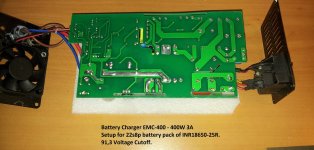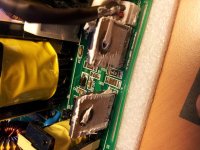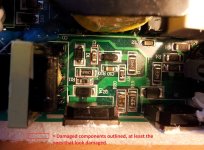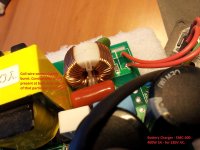Dear Community,
I've one of my burnt my charger for my 22s8p 18650INR-25R battery pack. The charger is a "Battery Charger - EMC-400 - 400W 3A".
Let me explain what happened. I plugged in the charger to the house 230V AC wall plug, the chargers' LED turned on. I left it like that for less then 10 seconds, and I plugged in my battery pack to start charging.
About 2 - 3 seconds in, the chargers' LED started flickering and it made some torturing noise. I quickly unplugged the battery from the charger and then the charger from the wall plug. I may recall a very small amount of smoke, but really not much, just enough for two burnt resistors. Since then the charger doesn't turn on anymore.
I read many different threads, and they all say the same thing; Current Inrush!!
What they don't say the same is what is the correct plugging steps.
But right now I would like some guidance towards fixing the charger.
You see in these photos, that there are small components that seems to have burnt. At least we can't read their ratings/values anymore.
Capacitor C11 and resistor R11 and R20 are the damaged components. And maybe the inductor, but not sure about that as I still have conductivity between the entrance and the exit of the inductor. BTW, what are inductor used for in these circuits?




I'm going to bring my new chargers to an electronic shop will and asked the guy if he has the same components available. Then will try to replace and solder them back.
I hoping to document this, as I haven't see many threads like this for an EMC-400.
I remember reading many post from Dnmun, he explains things very well.
Best regards,
Danoussh
PS: Why do I also have sparks when plugging the battery to the controller, when I connect the pre-charge cable that has an XT90. I though the whole point of these connector was to limit voltage potential difference using a small resistor and thus removing the spark. But I still seem to have a small sparks, which means my controllers' caps are charging up very quickly right? The value of the XT90 resistor seems to be only 10ohms I think from memory. That doesn't seem much.
I've one of my burnt my charger for my 22s8p 18650INR-25R battery pack. The charger is a "Battery Charger - EMC-400 - 400W 3A".
Let me explain what happened. I plugged in the charger to the house 230V AC wall plug, the chargers' LED turned on. I left it like that for less then 10 seconds, and I plugged in my battery pack to start charging.
About 2 - 3 seconds in, the chargers' LED started flickering and it made some torturing noise. I quickly unplugged the battery from the charger and then the charger from the wall plug. I may recall a very small amount of smoke, but really not much, just enough for two burnt resistors. Since then the charger doesn't turn on anymore.
I read many different threads, and they all say the same thing; Current Inrush!!
What they don't say the same is what is the correct plugging steps.
But right now I would like some guidance towards fixing the charger.
You see in these photos, that there are small components that seems to have burnt. At least we can't read their ratings/values anymore.
Capacitor C11 and resistor R11 and R20 are the damaged components. And maybe the inductor, but not sure about that as I still have conductivity between the entrance and the exit of the inductor. BTW, what are inductor used for in these circuits?




I'm going to bring my new chargers to an electronic shop will and asked the guy if he has the same components available. Then will try to replace and solder them back.
I hoping to document this, as I haven't see many threads like this for an EMC-400.
I remember reading many post from Dnmun, he explains things very well.
Best regards,
Danoussh
PS: Why do I also have sparks when plugging the battery to the controller, when I connect the pre-charge cable that has an XT90. I though the whole point of these connector was to limit voltage potential difference using a small resistor and thus removing the spark. But I still seem to have a small sparks, which means my controllers' caps are charging up very quickly right? The value of the XT90 resistor seems to be only 10ohms I think from memory. That doesn't seem much.


